Small overlap front: driver-side
Rating applies to 2022 models
Tested vehicle: 2014 Jeep Grand Cherokee Laredo E 4-door 4wd
The Jeep Grand Cherokee was redesigned for the 2011 model year. Beginning with 2013 models built after January 2013, the seat belts and airbags were modified to improve occupant protection in small overlap frontal crashes. (Information about when a specific vehicle was manufactured is on the certification label typically affixed to the car on the driver door or adjacent B-pillar.)
| Evaluation criteria | Rating |
|---|---|
| Structure and safety cage | |
| Driver injury measures | |
| Head/neck | |
| Chest | |
| Hip/thigh | |
| Lower leg/foot | |
|
Driver restraints and dummy kinematics
The dummy’s movement was reasonably well controlled. The dummy’s head remained largely in contact with the frontal airbag, but its head still moved toward the intruding A-pillar because the seat belt allowed excessive forward excursion of the dummy's head and torso. The side curtain airbag deployed but does not have sufficient forward coverage to protect the head from contact with forward side structure and outside objects. The side torso airbag deployed. | |
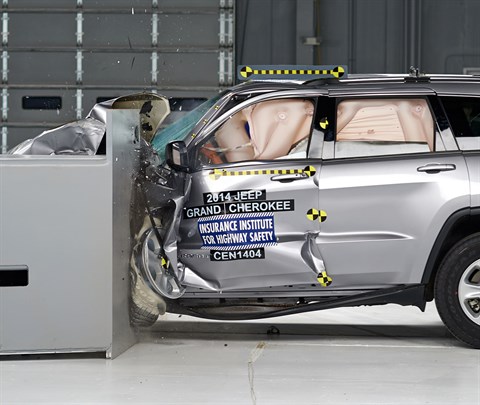
Action shot taken during the driver-side small overlap frontal crash test.
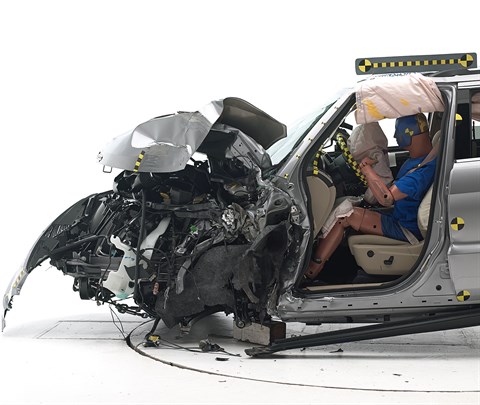
The dummy's position in relation to the door frame, steering wheel, and instrument panel after the crash test indicates that the driver's survival space was not maintained well.
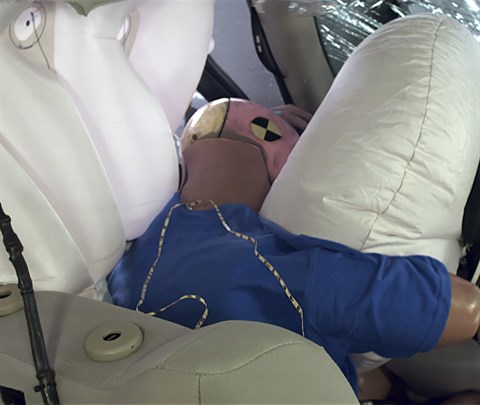
During the crash, the seat belt allowed the dummy to move too far forward, as is evident from the gap between the seat back and the dummy's torso. The side curtain airbag did not extend far enough forward toward the A-pillar.
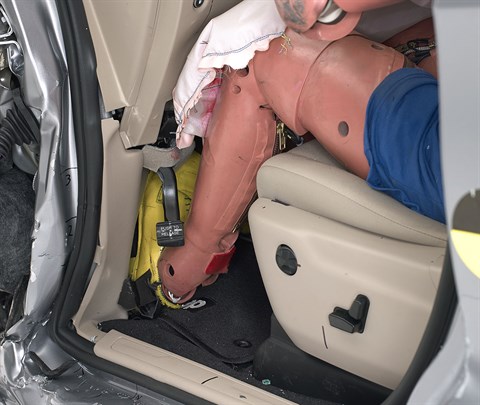
Intrusion of the parking brake pedal, door hinge pillar, and instrument panel contributed to a significant risk of injury to the left lower leg.
Small overlap front: passenger-side
Rating applies to 2022 models
Tested vehicle: 2018 Jeep Grand Cherokee Sterling 4-door 4wd
The Jeep Grand Cherokee was redesigned for the 2011 model year. Beginning with 2013 models built after January 2013, the seat belts and airbags were modified to improve occupant protection in small overlap frontal crashes. (Information about when a specific vehicle was manufactured is on the certification label typically affixed to the car on the driver door or adjacent B-pillar.)
| Evaluation criteria | Rating |
|---|---|
| Overall evaluation | |
| Structure and safety cage | |
| Passenger injury measures | |
| Head/neck | |
| Chest | |
| Hip/thigh | |
| Lower leg/foot | |
|
Passenger restraints and dummy kinematics
The dummy’s head loaded the frontal airbag, which stayed in front of the dummy until rebound. However, the side curtain airbag did not deploy and the front passenger door opened during the crash, which shouldn't happen because the passenger could be partly or completely ejected from the vehicle. In fact during rebound, the dummy's head moved outside the vehicle, leaving the head vulnerable to contact with side structure and outside objects. | |
| Driver injury measures | |
| Head/neck | |
| Chest | |
| Hip/thigh | |
| Lower leg/foot | |
| Driver restraints and dummy kinematics | |
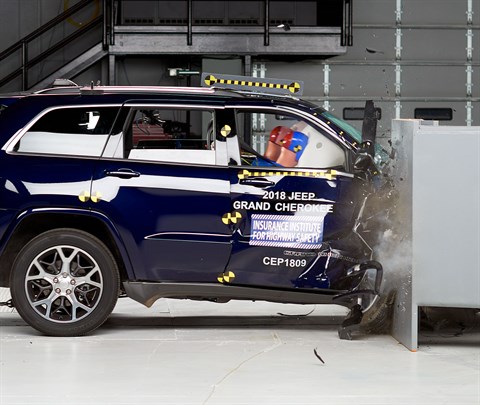
Action shot taken during the passenger-side small overlap frontal crash test.
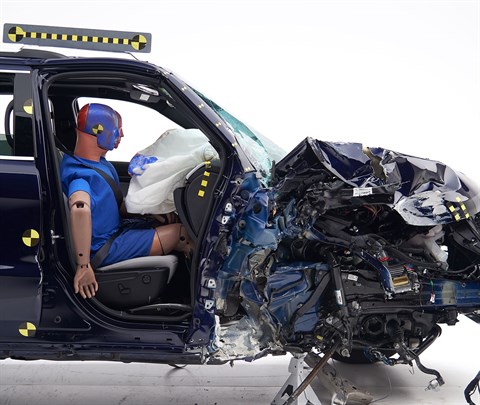
The dummy's position in relation to the door frame and dashboard after the crash test indicates that the passenger's survival space was not maintained well.
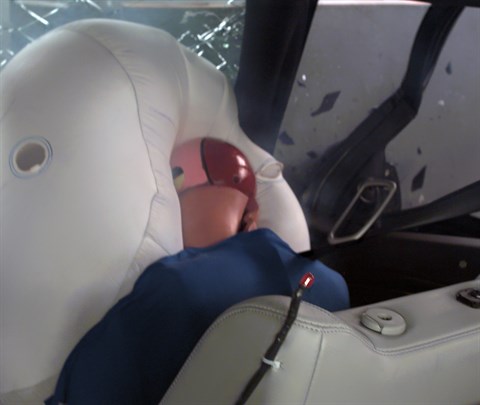
The side curtain airbag did not deploy, uncommon for 2018 model year and later vehicles, and the dummy's head bottomed out the frontal airbag and hit the dashboard hard.
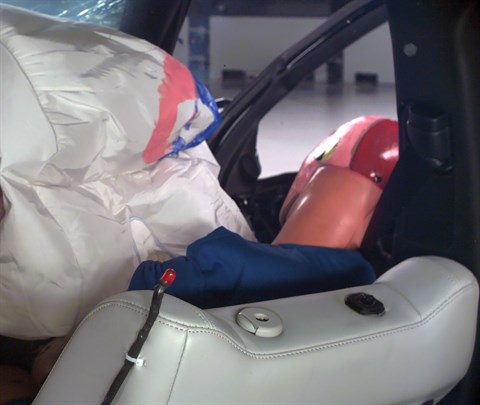
The passenger door opened during the crash test, and the dummy's head moved outside the vehicle during rebound.
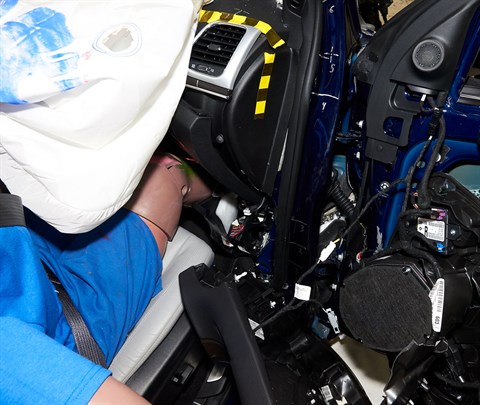
Intrusion of the dashboard and door hinge pillar contributed to a likely risk of injury to the right lower leg.
Moderate overlap front: original test
Rating applies to 2022 models
Tested vehicle: 2011 Jeep Grand Cherokee Laredo 4-door 4wd
The Jeep Grand Cherokee was redesigned for the 2011 model year. Moderate overlap frontal ratings are assigned by the Institute based on a test conducted by Chrysler Corporation.
| Evaluation criteria | Rating |
|---|---|
| Overall evaluation | |
| Structure and safety cage | |
| Driver injury measures | |
| Head/neck | |
| Chest | |
| Leg/foot, left | |
| Leg/foot, right | |
| Driver restraints and dummy kinematics | |
Side: original test
Rating applies to 2022 models
Tested vehicle: 2011 Jeep Grand Cherokee Laredo X 4-door 4wd with standard front and rear head curtain airbags and standard front seat-mounted torso airbags
The Jeep Grand Cherokee was redesigned for the 2011 model year.
| Evaluation criteria | Rating |
|---|---|
| Overall evaluation | |
| Structure and safety cage | |
| Driver injury measures | |
| Head/neck | |
| Torso | |
| Pelvis/leg | |
| Driver head protection | |
| Rear passenger injury measures | |
| Head/neck | |
| Torso | |
| Pelvis/leg | |
| Rear passenger head protection | |
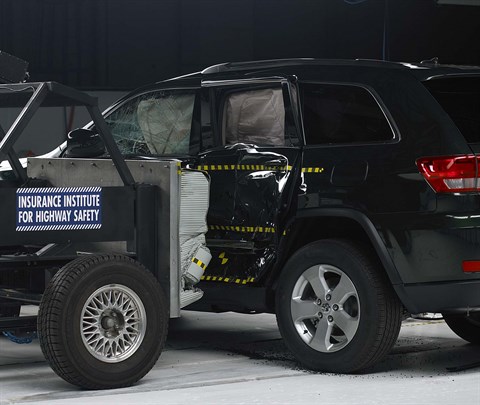
View of the vehicle and barrier just after the crash test.
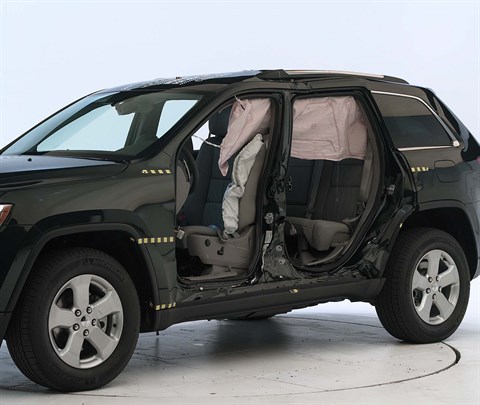
View of the vehicle after the crash with doors removed, showing the side airbags and damage to the occupant compartment.

Smeared greasepaint shows where the driver dummy's head was protected from being hit by hard structures by the side curtain airbag.
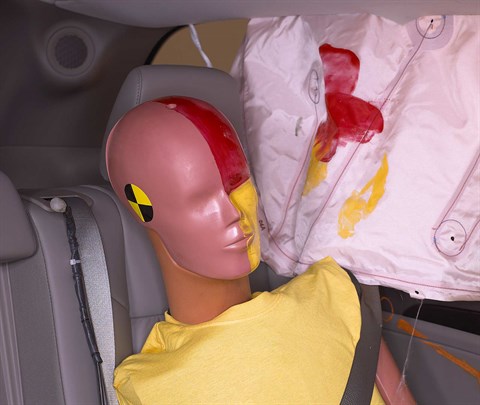
Smeared greasepaint shows where the rear passenger dummy’s head was protected by the side airbag.
Roof strength
Rating applies to 2022 models
Tested vehicle: 2011 Jeep Grand Cherokee Laredo 4-door 4wd
| Overall evaluation | |
|---|---|
| Curb weight | 4,655 lbs |
| Peak force | 21,545 lbs |
| Strength-to-weight ratio | 4.63 |
Head restraints & seats
Seat type: Power cloth seats (AHR)
| Overall evaluation | |
|---|---|
| Dynamic rating | |
| Seat/head restraint geometry |
About the head restraint & seat test
Currently, IIHS tests apply only to front seats.
Headlights
Ratings are given for 3 different headlight variations available on this vehicle.
Trim level(s)
- Limited trim equipped with Tech Group package
- Laredo X trim equipped with Tech Group package
| Evaluation criteria | Rating |
|---|---|
| Low-beam headlight type | HID projector |
| High-beam headlight type | HID projector |
| Curve-adaptive? | No |
| High-beam assist? | Yes |
|
Overall rating | |
| Distance at which headlights provide at least 5 lux illumination: | |
Low beams
On the straightaway, visibility was good on both sides of the road. On curves, visibility was good on both right curves and fair on both left curves.
The low beams created some glare.
High beams
On the straightaway, visibility was fair on the right side of the road and inadequate on the left side. On curves, visibility was fair on the gradual left and both right curves and inadequate on the sharp left curve.
High-beam assist compensates for some limitations of this vehicle's low beams on the straightaway, on both left curves and on both right curves.
Trim level(s)
- Laredo E trim equipped with Protech II package
- Laredo X trim equipped with Protech II package
| Evaluation criteria | Rating |
|---|---|
| Low-beam headlight type | Halogen projector |
| High-beam headlight type | Halogen reflector |
| Curve-adaptive? | No |
| High-beam assist? | Yes |
|
Overall rating | |
| Distance at which headlights provide at least 5 lux illumination: | |
Low beams
On the straightaway, visibility was inadequate on both sides of the road. On curves, visibility was inadequate in all 4 tests.
The low beams never exceeded glare limits.
High beams
On the straightaway, visibility was good on the right side of the road and inadequate on the left side. On curves, visibility was inadequate in all 4 tests.
High-beam assist compensates for some limitations of this vehicle's low beams on the straightaway and all 4 curves.
Trim level(s)
- Laredo E trim
- Laredo X trim
- Limited trim
| Evaluation criteria | Rating |
|---|---|
| Low-beam headlight type | Halogen projector |
| High-beam headlight type | Halogen reflector |
| Curve-adaptive? | No |
| High-beam assist? | No |
|
Overall rating | |
| Distance at which headlights provide at least 5 lux illumination: | |
Low beams
On the straightaway, visibility was inadequate on both sides of the road. On curves, visibility was inadequate in all 4 tests.
The low beams never exceeded glare limits.
High beams
On the straightaway, visibility was good on the right side of the road and inadequate on the left side. On curves, visibility was inadequate in all 4 tests.
Front crash prevention: vehicle-to-vehicle
Child seat anchors
Rating applies to 2022 models
| Evaluation criteria | Rating |
|---|---|
| Overall evaluation | |
| Vehicle trim | Laredo E |
| Seat type | cloth |
This vehicle has 2 rear seating positions with complete child seat attachment (LATCH) hardware.
It has 1 additional seating position with a tether anchor only.
| Evaluation criteria | Rating |
|---|---|
| Overall evaluation | |
| Vehicle trim | Laredo E |
| Seat type | cloth |
| Rating icon | Rating |
|---|---|
| G | Good |
| A | Acceptable |
| M | Marginal |
| P | Poor |
| Seating positions that rely on borrowed lower anchors or have only a tether anchor available are not rated. | |
thether anchor symbol | Tether anchor |
lower anchor symbol | Lower anchors |
| Lower anchor(s) can be borrowed from adjacent positions(s) | |
| No hardware available |
Details by seating position
| Position | Rating |
|---|---|
| 1 | |
| Tether anchor | |
| easy-to-find location | |
| other hardware could be confused for anchor | |
| Lower anchors | |
| too deep in seat | |
| not too much force needed to attach | |
| difficult to maneuver around anchors | |
| 2 | |
| Tether anchor | |
| easy-to-find location | |
| no other hardware could be confused for anchor | |
| Lower anchors | |
| none available | |
| 3 | |
| Tether anchor | |
| easy-to-find location | |
| other hardware could be confused for anchor | |
| Lower anchors | |
| too deep in seat | |
| not too much force needed to attach | |
| difficult to maneuver around anchors |